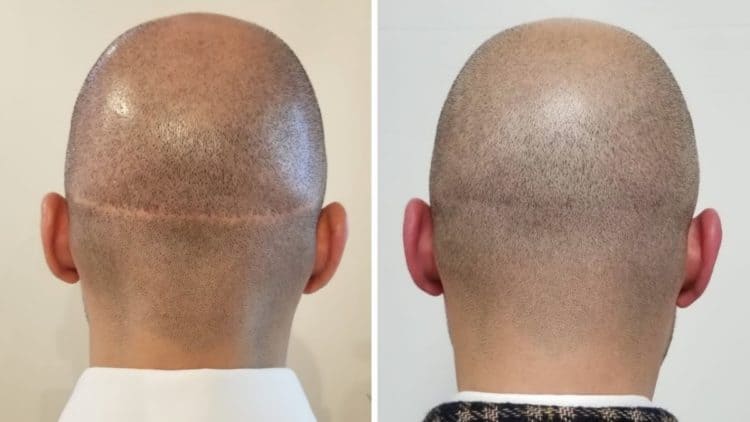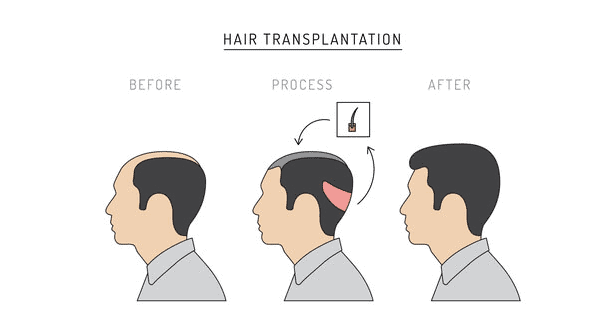Hair transplant procedures may have started out with crude techniques, leaving linear scars behind. However, with new advancements in treatment, transplants are now a viable hair restoration option. The new technology is even using robotics for pinpoint hair replacement accuracy..
A hair transplant scar is still evident in some types of hair transplant surgeries, leaving a noticeable line where follicles were harvested. There are also some ways to hide the scar by growing your hair out or with a pigmentation procedure.
If you’ve had a hair transplant and are now left with a visible scar. They are ways of dealing with or even hiding the scar. Read on to find out more.
What Type of Hair Transplant Scar Problems Can You Expect?
The type of scarring and extent of visibility depend on your skin type/color along with the elected hair transplanting technique.
Scars Caused by Hair Transplant Surgery
There are two types of surgeries available for hair transplants, commonly known as “Hair Plugs”. There’s a certain amount of scarring that occurs with each surgery, even if you have an experienced surgeon. Their skill and extraction instruments used may reduce the amount of scarring, however.
There are also new wound-closure procedures that have minimized scarring as well. The technique that you select for hair transplants may have a significant effect on the type of scarring and the size.

Follicular Unit Transplantation (FUT)
This procedure is also known as the strip method. This is the more invasive way to remove and transplant hair follicles. A piece of scalp is removed here to supply donor hairs that will be transplanted into recipient sites.
Once the strip of hair is removed, the area is then sutured back together. This leads to a rather nasty scar at the back of the head. The hair grafts are removed from the scalp strip and then placed into the recipient areas of the scalp. Small incisions are made here for each individual follicle.

Local anesthesia is used, and the stitches are removed about 10 days following the procedure. FUT patients have said that this procedure causes more pain and swelling than an FUE surgery (below).
What remains is a linear scar that runs across the back of the head.
Follicular Unit Extraction (FUE)
The FUE hair transplant procedure typically uses follicles from a graft taken off of your back and sides of the scalp. These are the donor areas that allow your doctor to remove each follicle and graft it individually onto your scalp using a micro-punching tool. Each follicular extraction will have a tiny scar that spans only 1 millimeter in diameter.
However, if you have hundreds of follicles removed, then you will have hundreds or thousands of little scars. These may turn into miniscule white dots after they heal. Every follicle contains one to four hairs, respectively.
Typically, you’ll get this procedure repeated several times over two to three months. This offers the best result for recovery and fuller, thicker hair.
FUT or FUE: Which Has Worse Scarring?
Out of the two procedures, most patients who choose FUE want to avoid scarring. The FUE white dot scars left behind in some cases are easier to disguise, whereas FUT can cause a long horizontal scar at the back of your head.
You should consult with your doctor about these scars before agreeing to a transplant surgery.
However, this also depends on your history with scarring, and whether you develop keloid scars. One thing to remember is that FUE also requires you to shave your head completely for most surgeries. This yields the most grafts to transplant and recreate your mature hairline.
Should You Get Scar Removal?
Many hair transplant patients go through scar removal after a surgery. This means that they may reduce the size and pigmentation of the scar, which is typically done for an FUT surgery due to the scar being more noticeable.
However, it’s not always successful in hiding all the scar. If you have very dark or tan skin, the scarred areas will likely be more noticeable.
Another way to fix a hair transplant scarring from FUT is using the FUE method. This involves another transplant surgery to recover after a previous transplantation. Since new technology has led to greater popularity for extraction techniques, you can cover the scar with new hair follicles.
In addition, scarred tissue may be thinned out using a medicated topical. This medication is the best treatment for those who want to avoid more surgery. However, it could take a few years to see significant results.
How to Conceal a Transplant Scar
Cosmetically, there are a number of ways to conceal the scar, but you should know that as your hair grows, it will cover most of the scar. In addition, keloid scars are more difficult to conceal as they are more raised and appear larger than the original surgical scar.
Keloid scars also have a tendency to grow over months and years. Some people more prone to this type of scarring due to genetics. If you have an issue with thick, raised scars such as keloid scarring, then you should let your doctor know before the hair transplant surgery.
Scalp Micropigmentation (SMP)
This procedure is also known as a medical hairline tattoo or scalp tattoo. This is a permanent technical procedure that injects pigment like your hair color into the scalp, which offers the appearance of thicker hair and disguises the scar entirely.
In fact, some people choose to go for a stubble shaven look and get scalp micropigmentation all over their head. The tattoo resembles actual follicles.
See our Complete Guide to Scalp Micropigmentation
Hiding Transplant Scars
Scalp micropigmentation for scars can be the best option if you have dealt with a long, raised keloid scar from a hair transplant surgery. The procedure is performed by a technician and typically takes multiple sessions to finish, depending on the size of the scar.
The ink is also chosen to match the color of your hair as well. If you have gray or lighter hair, you may not want to get scalp micropigmentation because it won’t look as realistic, or you may need to dye your hair.
There is some minor discomfort during the procedure, but it’s not unlike getting a tattoo. If you have issues with needles and pain, this may not be the best procedure. From personal experience, it’s not that bad.
Tricopigmentation (TMP)
Some hair transplant patients like to get TMP, which is a temporary version of the SMP procedure. This process involves semi-permanent inking. Needles inject the ink just to the top lay of the dermis.
This version doesn’t last as long as a traditional SMP surgery, but it can be helpful if you don’t want to tattoo your head permanently.
Reduce Appearance with Laser Treatments
The latest procedures involve the use of lasers. These can reduce significant scars and may be used in combination with SMP or TMP to completely hide the scar.
The laser targets the scarred skin on the surface, stimulating collagen at the dermis layer. This helps to rejuvenate the skin and sponsor new elasticity, leading to a reduction in the discoloration from the scar.
Results may vary, and it typically takes a few sessions to fully treat the scar.
Wrapping Up
In most cases, your hair will cover up most of the scars with an FUE transplant. However, FUT procedures have a much longer, prominent scar that spans the back of your head.
These scars are most often covered with SMP or TMP, which recreates the follicles using tattooed micropigmentation. This could be the best option if you have significant discoloration around your car.


